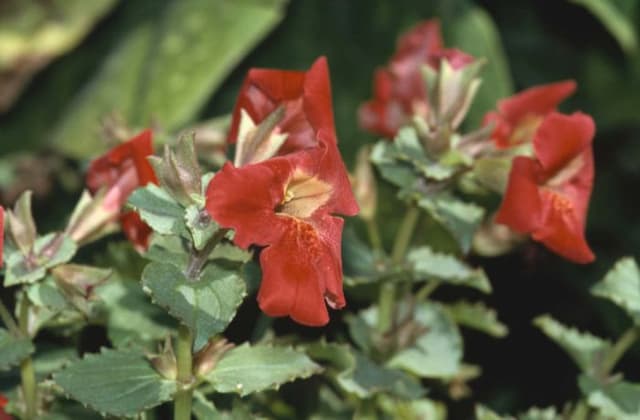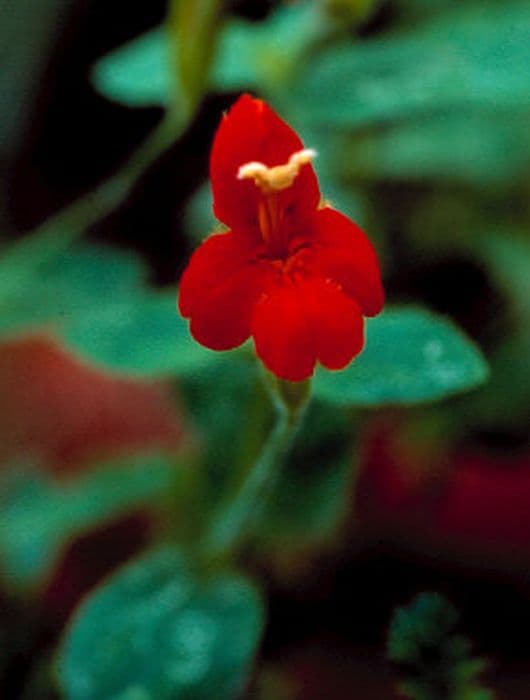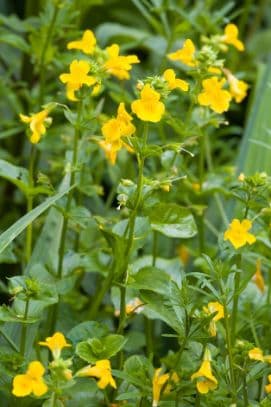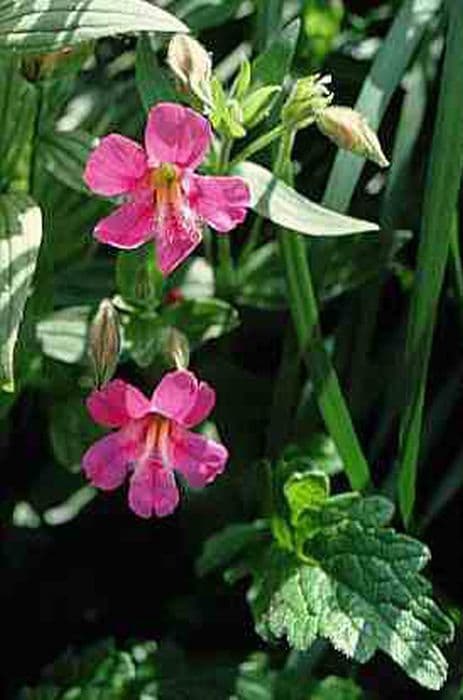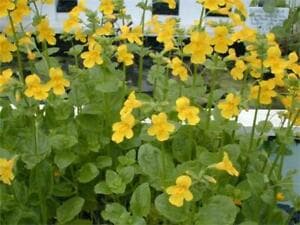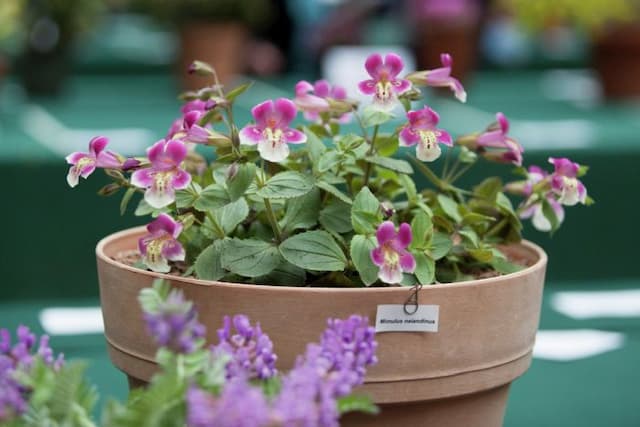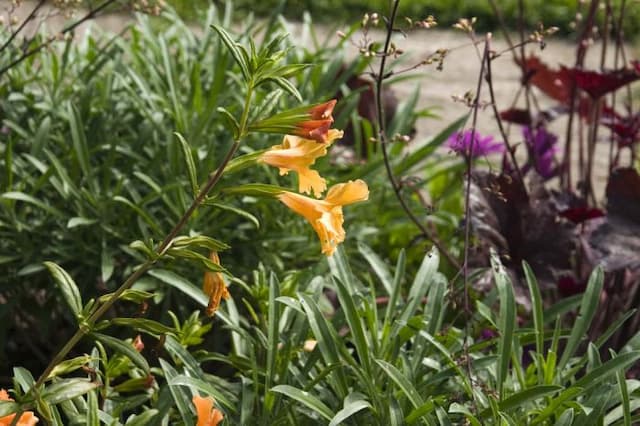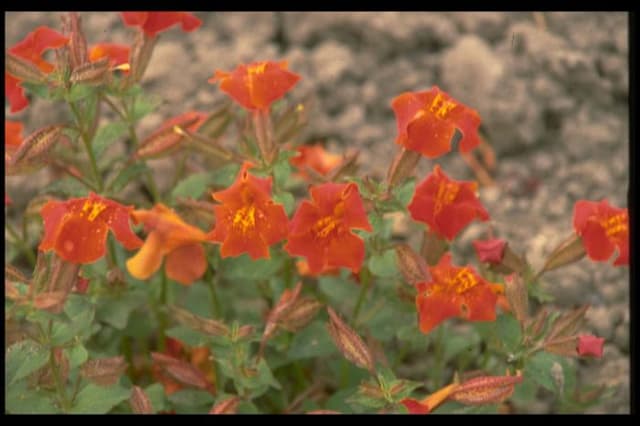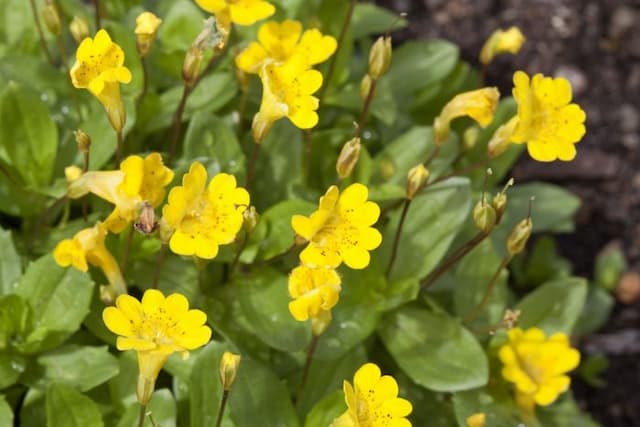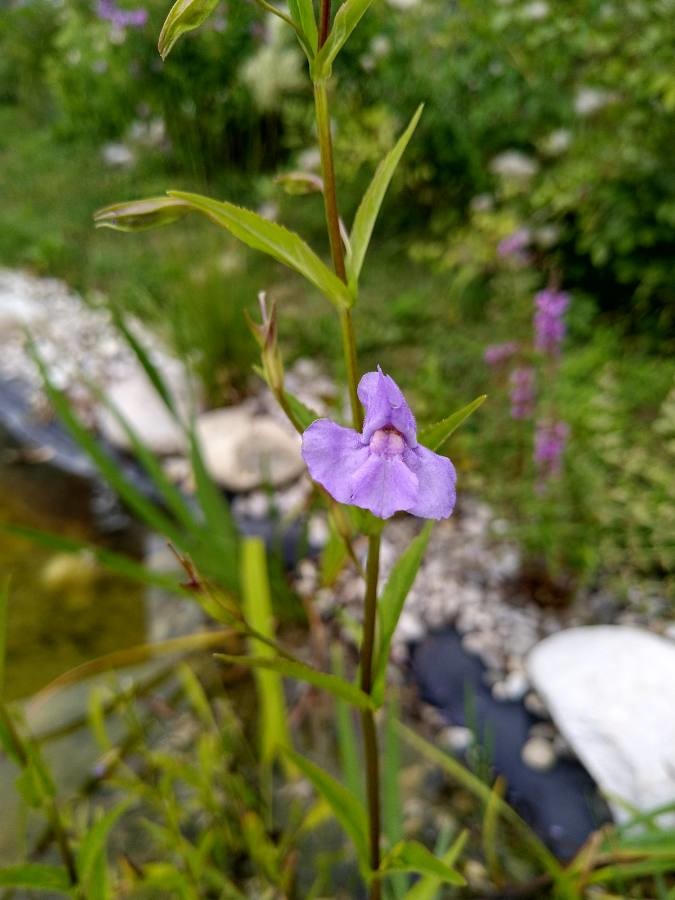Monkey Flower Mimulus Magic Series
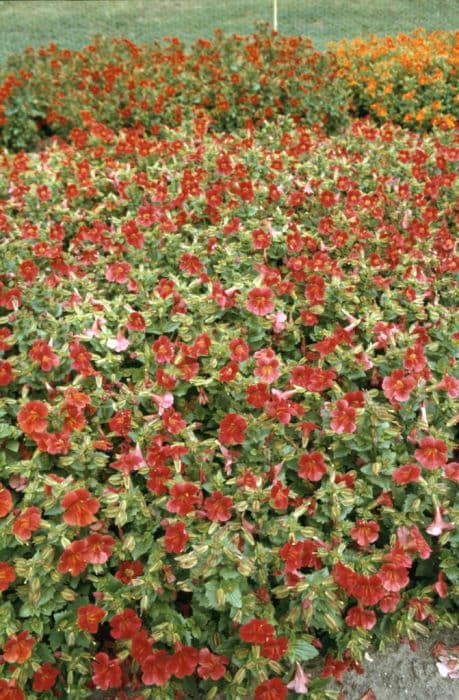
ABOUT
Mimulus Magic Series, commonly known as monkey flower, is known for its vibrant and cheerful appearance. This series boasts a wide array of colorful blooms that come in shades such as bright reds, oranges, yellows, pinks, and creamy whites, often combining several hues in intricate patterns. The flowers feature a unique, gaping mouth-like shape which is responsible for the common name, as they are reminiscent of a monkey's open mouth. Each flower has five lobes, with the lower three often speckled or streaked with contrasting colors, adding to their whimsical charm. The leaves of the monkey flower are also an attractive aspect of the plant. They are typically a lush green, sometimes having a slightly serrated edge, creating a nice backdrop that makes the flowers pop. The foliage can be somewhat sticky to the touch due to the presence of fine hairs, which gives the leaves a sheen when viewed in sunlight. In terms of growth habit, the Magic Series is known for producing a bushy, well-branched form. The plant tends to spread, forming a mounding or slightly trailing shape that is excellent for garden borders, hanging baskets, and as a colorful ground cover. The dense foliage and prolific blooming nature make it a favorite among gardeners looking to add persistent color through the blooming season. Overall, the Mimulus Magic Series is a delightful addition to any garden or container with its bright, showy flowers and pleasing green foliage. It often attracts hummingbirds and pollinators, adding another layer of dynamic activity to the spaces it inhabits.
About this plant
 Names
NamesFamily
Phrymaceae.
Synonyms
Monkey Flower, Magic Flower, Mimulus Magic.
Common names
Mimulus x hybridus, Mimulus x cultorum
 Toxicity
ToxicityTo humans
Monkey flower, which is the most common name for Mimulus Magic Series, is not known to be toxic to humans. Therefore, there are no specific symptoms associated with poisoning from this plant, as it is generally considered non-toxic. Ingesting parts of the monkey flower should not cause any harm, but consuming any plant material may potentially cause a reaction in sensitive individuals or if contaminated with pesticides or pathogens.
To pets
Monkey flower is not known to be toxic to pets. It is generally considered non-toxic to dogs, cats, and other animals. There are no specific symptoms of poisoning associated with the monkey flower, and ingestion of parts of this plant is not expected to result in any toxic consequences for pets. As with any non-food item, if a pet consumes a large amount of plant material, it might experience mild gastrointestinal upset.
 Characteristics
CharacteristicsLife cycle
Annuals
Foliage type
Semi-deciduous
Color of leaves
Green
Flower color
Varies
Height
1-2 feet (30-60 cm)
Spread
1 foot (30 cm)
Plant type
Herb
Hardiness zones
9
Native area
North America
Benefits
 General Benefits
General Benefits- Colorful blooms: The Mimulus Magic Series produces a vibrant array of flowers that can brighten up any garden space.
- Attracts pollinators: Its flowers are known to attract bees, butterflies, and other beneficial insects, thereby supporting biodiversity.
- Drought-tolerant: Once established, these plants can tolerate dry conditions, making them suitable for water-wise gardens.
- Shade tolerant: They can thrive in partially shaded areas, offering flexibility in garden design where sunlight is limited.
- Easy to grow: Mimulus plants are considered easy to cultivate, which makes them ideal for novice gardeners or those with less time for maintenance.
- Versatility: Suitable for use in borders, containers, hanging baskets, and as bedding plants, providing plenty of options for garden use.
- Long flowering period: They bloom from late spring into early fall, providing a long season of visual interest.
- Cooling effect: The plant's foliage and flowers can contribute to cooling down surrounding areas on hot days.
- Habitat enrichment: By adding structure and shelter, they can improve the habitat for small wildlife in the garden.
 Medical Properties
Medical PropertiesThis plant is not used for medical purposes.
 Air-purifying Qualities
Air-purifying QualitiesThis plant is not specifically known for air purifying qualities.
 Other Uses
Other Uses- The Monkey Flower can be used in pressed flower crafts due to their bright colors and interesting shapes, making them a unique addition to artisanal bookmarks, greeting cards, or framed botanical art.
- As a source of nectar, Monkey Flowers can be planted to attract and support populations of bees, butterflies, and hummingbirds, contributing to the health of local ecosystems.
- Monkey Flowers can be used as educational tools in schools and botanical gardens to teach about plant growth, hybridization, and pollination processes due to their diverse and vivid colors.
- They can serve as a natural food dye when used in a sustainable manner, as the flowers can provide pigments for coloring fabrics or foods in traditional practices.
- Monkey Flowers are suitable for water-conserving gardens or xeriscaping due to their moderate drought tolerance, once established they require less watering than many other ornamental plants.
- Used in container gardening, Monkey Flowers provide versatility in design and can be moved to places where a splash of color is desired, including patios, balconies, and other urban spaces.
- In landscape design, the Monkey Flower can be used as a 'spiller' plant in hanging baskets or as groundcover to create a carpet of color in garden beds.
- For photography enthusiasts and artists, Monkey Flowers offer an attractive subject because of their vivid hues and photogenic qualities, inspiring artwork and photography projects.
- The Monkey Flower can be utilized for live plant arrangements in combination with other plants to create colorful displays for events or as seasonal outdoor decor.
- These flowers can also be used in natural pest control strategies as part of companion planting schemes, helping to deter specific pests from more valuable crops or plants.
Interesting Facts
 Feng Shui
Feng ShuiMonkey flower is not used in Feng Shui practice.
 Zodiac Sign Compitability
Zodiac Sign CompitabilityMonkey flower is not used in astrology practice.
 Plant Symbolism
Plant Symbolism- Fearlessness: Mimulus, commonly known as monkey flower, symbolizes overcoming fear as its Latin name is derived from the word 'mimus' meaning 'mime' or 'actor', indicating the ability to face fears with different faces or masks.
- Protection: In some traditions, the monkey flower is thought to offer protection against negative energies and is used in floral arrangements to safeguard the home.
- Joyful Communication: The bright and varied colors of the Magic Series resemble a playful nature, encouraging open and light-hearted conversations.
- Versatility: With its ability to thrive in various environments, the monkey flower represents adaptability and resilience in diverse conditions.
 Water
WaterMonkey Flowers prefer consistently moist soil, so it's important to water them regularly. You should water these plants when the top inch of soil feels dry to the touch, typically about once or twice a week, depending on the climate and soil drainage. Depending on the size of the plant and the pot, use approximately 16 to 32 ounces of water at each watering session, making sure to water thoroughly until it begins to drain from the bottom of the pot. During the growing season in spring and summer, they may require more frequent watering, but always check the soil moisture level first to prevent overwatering.
 Light
LightMonkey Flowers thrive best in partial shade to full sun conditions. They should be placed in a spot where they receive morning sunlight and are protected from the intense heat of the afternoon sun. An eastern or northern exposure usually provides ideal light conditions for these colorful blooms. However, if you live in a cooler climate, full sun exposure can be suitable.
 Temperature
TemperatureMonkey Flowers prefer moderate temperatures and can tolerate occasional dips into the high 30s Fahrenheit, but they generally thrive in temperatures between 60°F and 75°F. They should be protected from frost, which can damage or kill the plant, so make sure to avoid exposure to temperatures below 32°F. The ideal temperature for growing a healthy Monkey Flower is within the aforementioned range; sustaining temperatures within this range will encourage the best blooming and growth.
 Pruning
PruningPruning Monkey Flowers is essential to promote bushier growth and more abundant blooms. They should be pruned in the spring at the beginning of the growing season to remove any dead or damaged growth and to shape the plant. Pinching off the spent flowers (deadheading) throughout the blooming season can encourage the plant to produce more flowers. After the main blooming season, a more thorough pruning can encourage a second flush of blooms.
 Cleaning
CleaningAs needed
 Soil
SoilMonkey Flower thrives in well-draining, moist soil enriched with organic matter. Aim for a slightly acidic to neutral pH, between 6.0 and 7.0, to ensure optimal growth.
 Repotting
RepottingMonkey Flower doesn't typically require frequent repotting. It should be repotted every 2-3 years, or when it outgrows its current container.
 Humidity & Misting
Humidity & MistingMonkey Flower prefers moderate to high humidity levels. Strive to maintain a humidity level around 50-70% for the best growth conditions.
 Suitable locations
Suitable locationsIndoor
For Monkey Flower indoors, ensure bright indirect light, consistent moisture, and good air circulation.
Outdoor
Plant Monkey Flower in partial shade, water regularly, and protect from strong winds.
Hardiness zone
9-11 USDA
 Life cycle
Life cycleThe Mimulus Magic Series, commonly known as 'Monkey Flower,' begin their lifecycle as seeds that require light to germinate, typically achieved by surface sowing them. After germination, which generally takes 7-14 days, the seedlings grow into juvenile plants with basic leaf structures. As these plants mature, they develop a more robust root system and foliage, reaching the vegetative stage where they focus on growth rather than reproduction. The next stage is the flowering phase, where the Monkey Flowers produce brightly colored blooms in various hues that attract pollinators. After pollination, these flowers will set seed, completing the sexual reproduction cycle. Finally, as annuals or short-lived perennials depending on the climate, Monkey Flowers will either die after seeding or enter dormancy, with the seeds lying in wait to start the next generation.
 Propogation
PropogationPropogation time
Spring-Early Summer
The Mimulus Magic Series, commonly known as Monkey Flower, is often propagated through seed sowing. The best time to sow Monkey Flower seeds is in early spring, indoors, around 6 to 8 weeks before the last frost date. To propagate by seed, fill a seed tray with a well-draining seed starting mix. Sprinkle the tiny seeds over the surface of the soil without covering them, as they need light to germinate. Moisten the soil gently using a fine mist to avoid disturbing the seeds. Place the tray in a warm location with plenty of indirect light and maintain a consistent temperature of around 70-75°F (21-24°C). Seedlings usually emerge within 10 to 14 days. Keep the soil moist but not waterlogged until the seedlings are ready to be transplanted after the danger of frost has passed.
